1918 Season
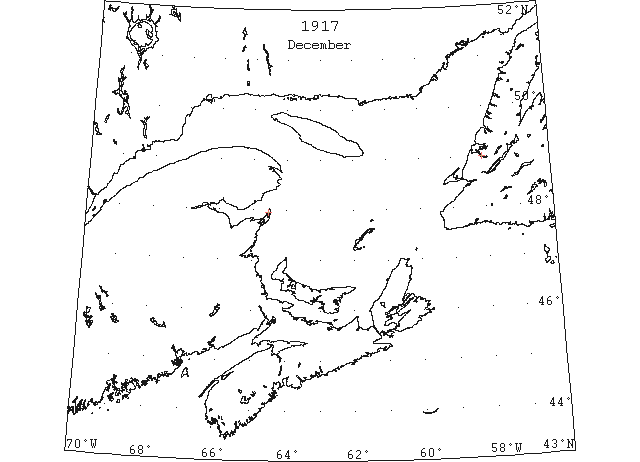
Dec 15 J.A. Ward, Lightkeeper, Miscou Point, New Brunswick: Closing date. (CIS IC0756)
Dec 19 Monday night’s keen frost formed a coat of ice over the Humber Sound which prevented fishermen from getting to their nets yesterday. (TWS, p.3).
Dec 23 Last departure of the season from Quebec. (WBB)
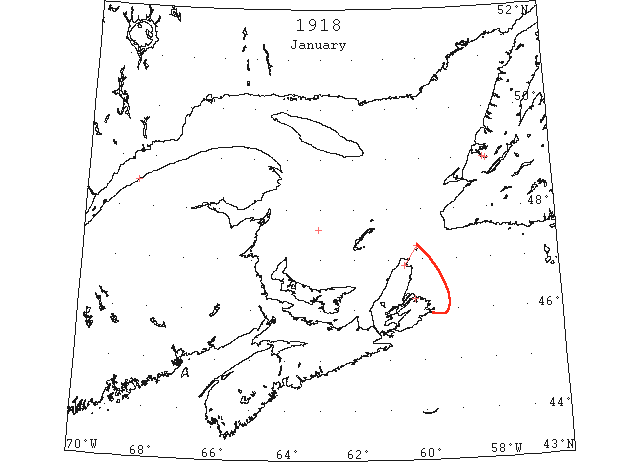
Jan- Feb Ice has been reported as follows: Very heavy ice was met in the Gulf of St. Lawrence during the last week of January and the first week of February. At one time it greatly impeded shipping on the Cape Breton side [of the Gulf of St. Lawrence], having drifted there under northeast winds, forming a barrier 40 miles wide. (HB 1486 Feb 20)
Jan 2 Mr. Tracey and Mr. Bellows while endeavoring to secure their herring nets fell through the ice into the chilly water. The little frost on Sat. coupled with the big fall of snow on Sun. and Mon. caused considerable slob ice to make in the Humber Arm, extending out to McCarty’s and today parties are crossing on it from Summerside to Curling. (TWS, pg. 3, Col. 2)
Jan 3 At 11:00 am there was no report of her (“Stanley”) arrival in Georgetown. Her movements will depend on the Captain’s report of the ice conditions. A train will leave here to connect with her, either at night or in the morning. Later: The “Stanley” arrived in Georgetown at 2:10 pm today. (Pat 3 Jan p1#2)
Jan 7 47°36’N 63°02’W icebergs (field ice (?)). (HB #1481 Jan 16)
Jan 9 On Fri. the “Ethie” came to the entrance of the Humber Arm but finding the Arm then full of slob ice out as far as McCarty’s Cove, she went to Lark Harbor to report. She then went to Middle Arm and loaded with herring for St. John’s (TWS, pg. 2, Col. 4)
Jan 10 On Thur. teams crossed on ice over the Humber from Summerside to Curling. The mild weather prevailing since then, however, has taken away the ice almost completely. (TWS, pg. 3, Col. 3)
Jan 10 The “Stanley” which left Pictou yesterday morning arrived at Amherst Island, Magdalene Islands at 7:00 last night. (Pat 11 Jan p5#6)
Jan 16 A thin coating of ice made over the Humber yesterday and the previous night. (TWS, pg. 3, Col. 3)
Jan 16 Another steamer from the Great Lakes is safe in Halifax harbor after getting thru the ice from the St. Lawrence to the Strait of Canso. She is the “Briton,” 1875 tons net. She makes the third lake steamer to arrive here in a week, the other two being the “Bethehem,” and “Seneca. The “German,” which was also caught in the ice off Father Point with three other lake steamers, has reached Sydney. The others, now at the Strait of Canso, are the “Key North,” “Key West” and “Cicoa.” The four vessels succeeded in getting clear of the ice floes without any serious mishap. (HH 16/01/1918 p9#6)
Jan 19 Another Lake steamer from out of the ice pack in the Gulf of St. Lawrence showed up in Halifax harbor yesterday. She is the “Adrian Iselin”. (HH 19/01/1918 p11#6)
Jan 22 Halifax, the “Seal” arrived yesterday from Newfoundland port via North Sydney and Louisburg. On this trip from Newfoundland, Captain Poole said that he did not meet any ice until nearing the Cape Breton coast and the first was between St. Paul’s Island and Cape North, the “Seal” ploughing thru it for a stretch of ten miles. (HH 22/01/1918 p9#6)
Jan 22 After a belated passage from Prince Edward Island with a cargo of potatoes, the trip being lengthened out on account of ice conditions in the Northumberland Strait and Strait of Canso and bad weather since clearing the latter, the schooner “Talmouth” arrived here [Halifax] yesterday and is lying in the stream. (HH 22/01/1918 p9#7)
Jan 22-23 From 10 pm to 12:15 am in approximately 39°12’N 74°18’W passed through broken ice for 2 ½ hours. It was covered in snow and extended as far as we could see. [no vessel name] (HB #1484 Feb 6)
Jan 23 Ice has been reported as follows: 40°30’N 74°04’W, steamed through thick fields of ice; 39°02’N 74°14’W, steamed through fields of ice. (HB 1485 Feb 13)
Jan 25 From 6 miles off Five Fathom Bank Lightship to 2 miles off Northeast End Lightship, large quantities of ice. (HB #1484 Feb 6)
Jan 26 Halifax, there steamed into port yesterday the lake steamer “German” which, previous to her arrival at Sydney, was imprisoned for three weeks in the Gulf of St. Lawrence along with three other lake boats, and almost every minute of that time was threatened with being crushed and sunk. All, including the “German,” were more or less damaged as a result of the constant grating of the immense ice floes against their sides. Captain Hiltop is master of the “German.” He says that his ship happened to get thru the rafted ice with less difficulty that the other boats, even making the way for the government ice-breaker “Lady Grey,” which followed in the wake of the “German” and proved absolutely useless so far as aiding the icebound vessels. Captain Hiltop proved an admirable ice navigator and altho his ship was lightly damaged he made Sydney safely. As it was feared the “German” would be caught in the ice jam that closes up navigation along the Sydney waterfront many weeks before the port of North Sydney, she was towed to the latter place by her sister ship, the “Adrian Iselin,” now at Halifax. (HH 26/01/1918 p15#6)
Jan 30 No drift ice was reported along the coast up to Mon. A little slob ice coming out of North Bay was met in the Cabot Strait a few days [ago?] (TWS, pg. 2, Col. 3)
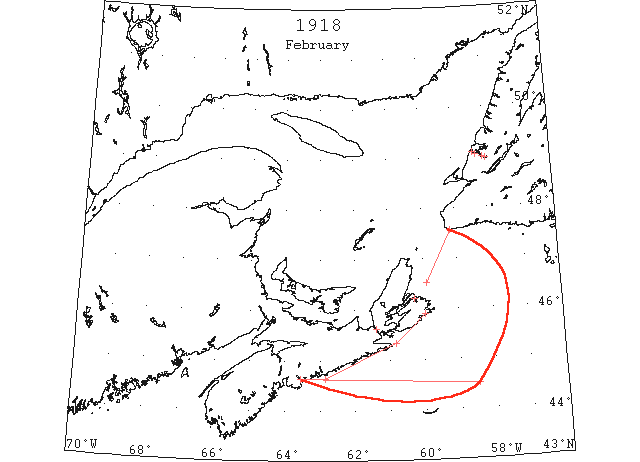
Feb 1 The tail enders of the lake fleet of steamers are limping towards Halifax from the ice bound St. Lawrence. One belated craft arrived yesterday, the “Key West” 1,298 tons net, was released from the ice by an American naval tug which went from Halifax to the Strait of Canso to render assistance. (HH 01/02/1918 p11#6)
Feb 3 Ice has been reported as follows: The following is a report by Mr. Geo. W. Scott, Gloucester, Mass., under the date of Feb. 3, 1918: “Capt. Geo. Peeples, who just arrived from Newfoundland, reports about 7 inches of ice in Green and Halls Bays [of Newfoundland]. He took a steamer from Port aux Basques for Sydney, C.B.I. After leaving Port aux Basques, encountered heavy ice which extended about 70 miles from point of debarkation, and which was difficult to steam through. Captain Peeples was in that section of Newfoundland for three months and reports the winter the mildest he ever experienced there.” (HB 1485 Feb 13)
Feb 5 Ice has been reported as follows: Barnegat [New Jersey] bearing W. (true), about 12½ miles distant, steamed through a field of heavy floe ice. (HB 1485 Feb 13)
Feb 6 A bridge was formed over Humber Arm on Thur., and on Fri people were able to cross on it from Summerside. (TWS, pg. 3, Col. 1)
Feb 6 Ice has been reported as follows: About 20 miles N. by E. of Winter Quarter Shoal Lightship, ran into fields of drift ice. (HB 1486 Feb 20)
Feb 6 Ice has been reported as follows: 38°47’N 74°28’W, heavy drift ice extending northward and southward along the coast. (HB 1485 Feb 13)
Feb 9 Halifax, Halifax appears to be taking second place this winter in food stuff shipments to Newfoundland. North Sydney still holding first place in spite of the ice conditions on the Cape Breton coast a factor in driving the freighters to Halifax last winter for their cargos. An idea of the thickness of the ice bridge of the harbor, separating North Sydney from Sydney may be learned when it is stated that the “Sagona,” an ice boat at that took eight hours to make the international pier a distance of about two miles from the outer edge of the ice barrier. (HH 09/02/1918 p7#6)
Feb 11 Halifax, on the return voyage to Halifax [from Louisburg], the “Nevada” steamed thru slob ice all the way. (HH 12/02/1918 p12#6)
Feb 11 Halifax, February 1[1]- The first sailing craft to arrive this year from Newfoundland is the “Carrie and Nellie” from Grand Bank, having left that port a week ago. The vessel had fine weather leaving the Newfoundland coast and not until nearing Quero was there a change. From there to port the weather was anything but agreeable and plenty of ice retarded the progress of the vessel which on one stretch sailed thru sixty-five mile of it. (HH 12/02/1918 p12#6,7)
Feb 13 Issue: mention of ice off Cape Breton coast. (NYMR)
Feb 13 The ice on the south side of the Bay extends from Harbormouth to Lark Harbor. 3 schooners of T.M. Nickson are still at Woods Island yesterday and the Bay of Islands is still filled with ice (TWS, pg. 3, Col. 4)
Feb 16 Halifax, a direct run was made from Louisburg, ice conditions were about as bad as they could be but in spite of this and the storm the “Cruizer” brought the “Laugen” to Halifax under thirty hours. (HH 16/02/1918 p15#6)
Feb 21 Halifax, yesterday the Gloucester schooner “Smuggler” hauled into Smith’s wharf to effect repairs. She sailed from Bay of Islands with two other Gloucester bound vessels. The other two kept on but the “Smuggler” put into Lark Harbor and it was after leaving there that she sustained damage by heavy weather and besides was caught in the ice off the Cape Breton coast. (HH 21/02/1918 p11#6)
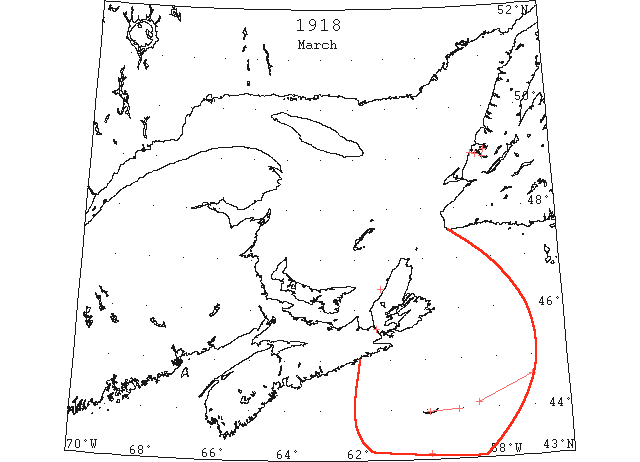
Mar 5 Riding at anchor on the Dartmouth side of the harbor, is the Canadian lake steamer “Edmonton,” which has been “up against it” twice since leaving the St. Lawrence river in December. First, as related on this page in the issue of Friday last, she was abandoned by the crew in the Gulf of St. Lawrence and was afterwards picked up in the ice by a United States naval tug and towed into a Prince Edward Island port. (HH 05/03/1918 p11#6)
Mar 6 There is very good ice boating on the Humber at present. Some of the people who left for Middle Arm last Thur. had to return owing to the ice around Middle Arm Point being smashed up and the road across the Neck being bad. (TWS, pg. 3, Col. 1)
Mar 12 Issue: “John L Cann” engaged in Canso – Mulgrave service broke propeller in ice and will go to Halifax. (NYMR)
Mar 18 Halifax: SS “Rayander” broke blades in ice in Straits of Canso. (NYMR)
Mar 20 The Bay is now filled with ice, and that the outer part of the Bay is very rough. (TWS, pg. 2, Col. 1)
Mar 20 Another arrival yesterday was the DGS “Stanley” which was sent out to rescue the Russian steamer reported in distress some miles off the Cape Breton coast. Captain Rowe reports that his ship reached a point 115 miles southeast of Canso and from there it was solid packed ice to Sable Island. It was found impossible to break through this ice barrier without unreasonable delay and to reach the disabled steamer the “Stanley” would have to go way around the southern end of Sable Island. This idea was given up because of the boisterous weather prevailing and for the time being the efforts of rescue were abandoned. Captain Rowe said that on this trip out the ice conditions were practically the worst in all his experience and even men who have been on this well-known ice-breaker longer than the captain said they never before seen the like of it. (HH 21/03/1918 p9#6)
Mar 21 44°37’N 57°02’W to 44°06’N 58°33’W a heavy ice field. (NYMR)
Mar 22 Forced to sail 260 miles south of Sable Island to clear the ice field that she might reach Halifax, her port of destination, the 87 ton schooner “Nellie Moulton,” arrived yesterday from Burgeo, Nfld., after a passage which occupied fifteen days. (HH 23/03/1918 p7#6)
Mar 27 Because of a continuous stretch of ice from Scatarie to beyond Sable Island, the Reid-Newfoundland steamer “Meigle” in order to reach Halifax, had to fifty miles south of the “Graveyard” of the Atlantic,” and even at this point she was obliged to plough her way thru miles of ice fields. (HH 27/03/1918 p9#6)
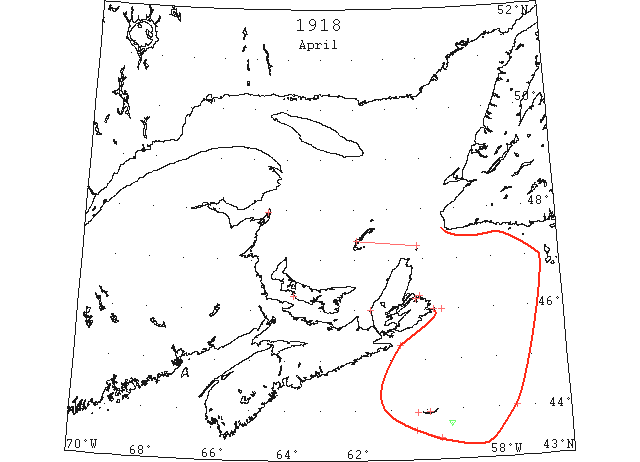
Apr 4 J.A. Ward, Lightkeeper, Miscou Point, New Brunswick: Opening date. (CIS IC0756_2)
Apr 4 Between 44°N 47°W and 46°N 59°30’W heavy field ice reported. (HB #1496 May 1)
Apr 8 Sydney, C.B. An unusual sight as observed a few days ago when a flock of about half a hundred sheep floated out to sea on drifting ice. The sheep strayed out on the ice when it was on the shore. The rising tide and offshore wind carried the ice field with the sheep into deep water to sea before the flock could be rescued. (Pat 12 Apr p1#2)
Apr 12 West of Sable Island, heavy field ice. (HB #1496 May 1)
Apr 13 44°01’N 57°30’W steamed through a small quantity of field ice. (HB #1498 May 15)
Apr 13 43°35’N 60°19’W and 43°26’N 59°37’W large flat ice. (HB #1499 May 22)
Apr 15 Another Sunday arrival was the “Mary F Hyde,” from Grand Bank, Newfoundland. She met plenty of ice on the passage and had to run south of Sable Island to clear it. (HH 15/04/1918 p11#6)
Apr 15 The ice barrier along the Cape Breton coast is moving out to sea and small craft are now able to work along the shore. (HH 15/04/1918 p11#6)
Apr 17 Off Cape Canso large quantities of field ice drifting southeastward. (HB #1497 May 8)
Apr 20 It was originally intended that the [lobster] season should open on Friday next, the 26th of April, but owing to the heavy ice, which still lingers around the coast it was decided to defer the opening of the season until the 6th of May. (Pat 23 Apr p1#5 & 6)
Apr 21 43°43’N 59°20’W, 2 icebergs. (HB #1497 May 8)
Apr 22 Halifax, the “Meigle” brought passengers and the Newfoundland mails. Captain Cross reports a fair passage but had to go south of Sable Island to clear the ice field. (HH 22/04/1918 p9#6)
Apr 24 Montreal to Anticosti no ice; Magdalens to St. Paul’s Island, light open ice; Cape Ray and Point Tupper, no ice. Flat Point, heavy close packed; Scatari, heavy close packed in shore; Tormentine, open ice distant; Port Hood, ice moving outside. (HH 25/04/1918 p11#7)
Apr 25 About 10 miles E of Scatari closely packed field ice. (HB #1497 May 8)
Apr 28 The first sailing vessel to enter the port of Charlottetown this season was the schooner “Blake” from Victoria. She came in on Sunday. (Pat 1 May p8#3)

May 3 Heavy field ice from north of Sable Island to the shore of Nova Scotia. Drift ice around St. Paul’s Island, Cabot Strait. (NYMR)
May 3 One of the steamers of the merchant marine was at this port, lying in the stream, spent two weeks trying to force a passage up the Gulf of St. Lawrence. The vessel is light, otherwise she might have found it less difficult in getting thru the ice barrier to Montreal whither she was bound. (HH 03/05/1918 p11#6)
May 4 Halifax, two more Newfoundland schooners are in port, the “Atalaya” from Grand Banks and “Harry Lewis,” from Fortune Bay, arriving yesterday. The former brought 1,700 quintals dry cod for N and M Smith and was ten days on the passage, bad weather and the fact that she had to go as far south as Sable Island to clear the ice floes being the cause of the lengthened voyage. The “Oliver F Kilham” arrived Thursday evening form Burin, Nfld, made a very quick passage from the Newfoundland port, only three days making the trip and the vessel had to run near Sable Island to clear the ice fields. (HH 04/05/1918 p7#6)
May 4 Halifax, among Saturday’s arrivals was the “Garfield” She was five days coming from St. Pierre and to clear the ice fields had to run seventy miles south of Sable Island. (HH 06/051918 p11#6)
May 7 First arrival of season at Quebec. (WBB)
May 11 The first American steamer arriving in Halifax direct from the Great Lakes this year is the “Alfred Mitchell” which came into port Saturday by way of the Strait of Canso. She had some difficulty with ice in the Gulf but not so much as was anticipated at this season of the year. (HH 13/05/1918 p9#6)
May 13 Field ice around Sable Island. (NYMR, p.14, col.3).
May 13 Pack ice in Cabot Strait. (NYMR, p.14, col.3)
May 19 In Cabot Strait, packed ice. (HB #1501 Jun 5)
May 19 Off Sydney heavy ice. (HB #1501 Jun 5)
May 19 Off Sable Island, field ice. (HB #1501 Jun 5)
May 21 39°49’N 56°40’W two small pieces of ice drifting in a SE direction. (HB #1501 Jun 5)
Jun 5 First Westbound steamer through the strait of Belle Isle. (WBB)